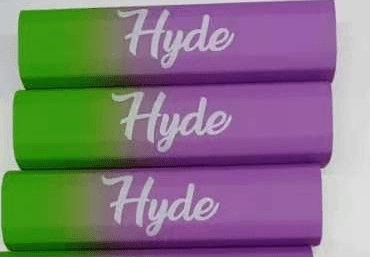The Art of Gradient Coating in Vape Manufacturing: Techniques and Trends in the Vape Industry
The vaping industry has seen tremendous growth over the past decade, with innovations in design, technology, and aesthetics driving consumer interest. One of the most visually appealing trends in vape device manufacturing is the use of gradient coating, a technique that creates a seamless transition between colors on the surface of e-cigarettes. This process not only enhances the visual appeal of vape devices but also reflects the craftsmanship and attention to detail that goes into their production. In this article, we’ll explore the gradient coating process in vape manufacturing, its significance in the industry, and how it aligns with the latest trends in vaping.
Understanding Gradient Coating in Vape Manufacturing
Gradient coating, also known as ombre coating, is a specialized painting technique used to create a smooth transition between two or more colors on the surface of vape devices. This process is widely used in the vaping industry to produce visually striking e-cigarettes that stand out in a competitive market. The gradient effect is achieved through a combination of precise spraying techniques, high-quality materials, and meticulous attention to detail.
Why Gradient Coating Matters in the Vape Industry
- Aesthetic Appeal: Gradient-coated vape devices are highly sought after for their unique and eye-catching designs. They appeal to consumers who value both functionality and style.
- Customization: The gradient coating process allows for a high degree of customization, enabling manufacturers to create devices that cater to individual preferences.
- Brand Differentiation: In a crowded market, gradient-coated vapes help brands distinguish themselves from competitors by offering visually distinct products.
- Durability: When done correctly, gradient coating not only enhances the appearance of vape devices but also provides a protective layer that increases their durability.
The Gradient Coating Process: Step-by-Step
The gradient coating process requires skill, precision, and an understanding of the materials involved. Below is a detailed breakdown of the steps involved in achieving a flawless gradient finish on vape devices.
1. Preparation
Before the coating process begins, thorough preparation is essential to ensure a high-quality finish.
- Materials: Gather all necessary materials, including spray guns, paints, solvents, and primers. High-quality pigments and binders are crucial for achieving a smooth gradient effect.
- Surface Cleaning: The surface of the vape device must be cleaned thoroughly to remove any dust, grease, or contaminants that could affect the adhesion of the coating.
- Environment: The spraying environment should be clean, dry, and free from dust or debris. A controlled environment minimizes the risk of imperfections in the final coating.
2. Base Coating
The base coat serves as the foundation for the gradient effect.
- Primer Application: Apply a primer to the surface of the vape device. The primer not only protects the surface but also improves the adhesion of the subsequent layers.
- Color Selection: Choose a base color that complements the gradient effect. The base coat can either match one of the gradient colors or provide a contrasting background.
3. Gradient Coating
This is the most critical step in the process, where the gradient effect is created.
- Spraying Technique: Using a spray gun, begin applying the first color. Gradually transition to the second color by adjusting the spray distance, angle, and pressure. This requires a steady hand and a keen eye for detail.
- Layering: Apply multiple thin layers to build up the gradient effect. This ensures a smooth transition between colors and prevents uneven patches.
- Blending: Use tools like airbrushes or masking techniques to blend the colors seamlessly. The goal is to create a natural transition without visible lines or harsh edges.
4. Defining Transition Areas
To achieve a natural gradient, it’s important to define the transition areas between colors.
- Masking: Use masking tape or stencils to create sharp boundaries or soft transitions, depending on the desired effect.
- Blending Tools: Tools like sponges or soft brushes can be used to manually blend the colors while the coating is still wet.
5. Top Coating (Clear Coat)
Once the gradient coating is complete and dry, a clear top coat is applied to protect the finish and enhance its durability.
- Application: Use a transparent gloss or matte finish to seal the gradient coating. This layer adds shine and protects the surface from scratches and wear.
- Evenness: Ensure the top coat is applied evenly to avoid bubbles, streaks, or uneven spots.
6. Quality Control
The final step involves a thorough inspection to ensure the coating meets quality standards.
- Visual Inspection: Check for imperfections such as bubbles, cracks, or uneven color transitions.
- Durability Testing: Test the coating for resistance to scratches, fingerprints, and other forms of wear.
- Customer Approval: Ensure the finished product aligns with the customer’s specifications and expectations.
Challenges in Gradient Coating for Vape Devices

While gradient coating offers numerous benefits, it also presents several challenges that manufacturers must address:
- Consistency: Achieving a consistent gradient effect across multiple devices can be difficult, especially in large-scale production.
- Drying Time: Each layer of coating requires adequate drying time, which can slow down the production process.
- Environmental Factors: Humidity, temperature, and dust can affect the quality of the coating.
- Material Compatibility: Not all paints and solvents are suitable for use on vape devices, which may come into contact with heat and e-liquids.
Trends in Gradient Coating for Vape Devices
The vaping industry is constantly evolving, and gradient coating techniques are no exception. Here are some of the latest trends in this area:
- Custom Color Combinations: Manufacturers are offering personalized color options to cater to individual preferences.
- Matte Finishes: Matte gradient coatings are gaining popularity for their sleek, modern look.
- Holographic Effects: Some manufacturers are experimenting with holographic pigments to create iridescent gradient effects.
- Eco-Friendly Materials: There is a growing demand for environmentally friendly paints and coatings in the vaping industry.
Discover more from Ameca-mall
Subscribe to get the latest posts sent to your email.

